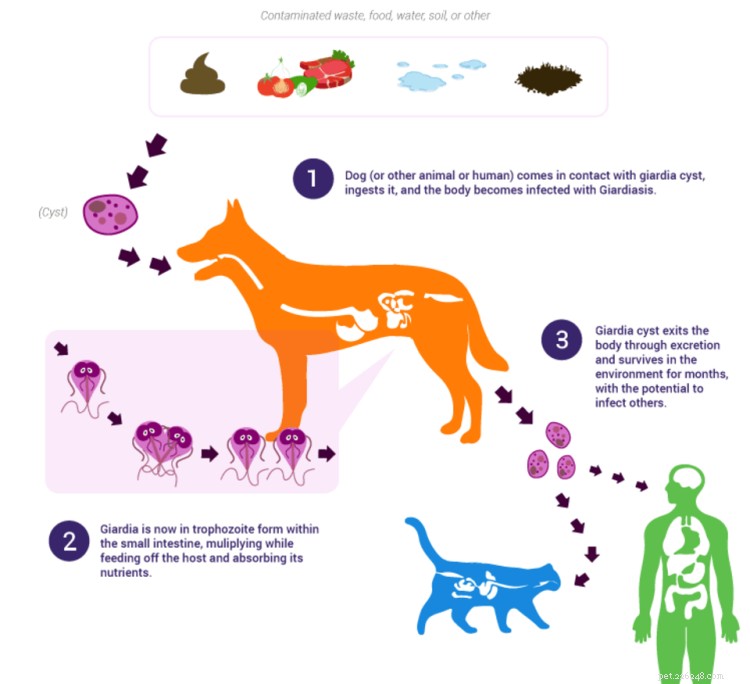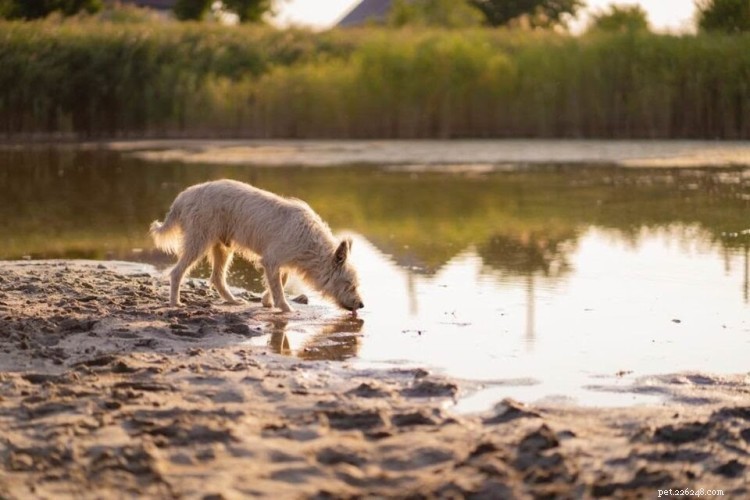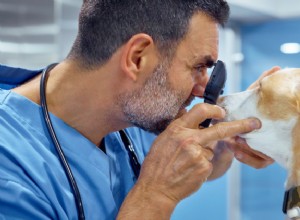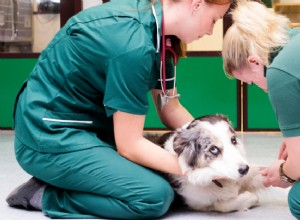ジアルジアは、犬、猫、および人間の間で簡単に伝染する一般的な寄生虫です。下痢や嘔吐などの症状を引き起こしますが、幸いなことに、ペットの親が子犬を感染から守るためにできる対策がいくつかあります。
あなたの愛する人を安全に保つために、犬のジアルジア症の原因、症状、治療について知っておくべきことはすべてここにあります.
プロのヒント :一部のペット保険では、ジアルジア症、ケンネルコフ、パルボなどの状態が既存のものではなく、必要または推奨されるすべての予防接種が現在行われており、予防措置が講じられている場合に限り、これらの状態をカバーしています。
目次:
ジアルジア、別名 Giardia duodenalis または Giardia intestinalis 獣医学用語では、哺乳類、両生類、鳥類の腸内で増殖する単細胞の寄生虫です .
ジアルジア寄生虫には、シストとトロフォゾイトのさまざまな形態がありますが、どちらも犬に同様の影響を与えます.栄養型は小腸に生息する成熟した寄生虫であり、最終的にシストになり、感染した動物の糞便に排出されます。シストは、湿ったまたは寒い条件でも、さまざまな環境で数週間または数か月生き残ることができます.
犬は摂取するとジアルジアに感染する可能性があります 寄生虫の。糞便で汚染されたもの (草、棒など) を食べたり、汚染された水 (水たまり) を飲んだりすることがあります。犬はあらゆる種類のものを噛むのが得意なことで知られているため、ジアルジア感染のリスクはかなり高い.
犬のジアルジア感染症は、子犬が汚染された土壌で遊んだり転がったり、汚染された表面 (犬の木枠、トイレなど) に触れた後に体を舐めたりすることによっても広がる可能性があります。
ジアルジアが犬の腸に入ると、ペットが感染の症状を示さなくても、寄生虫が拡散する可能性があります.これは、特に家に複数のペットを飼っている人にとっては、非常に問題になる可能性があります.異種間の感染はまれですが、寄生虫は犬から犬へと容易に伝染します。したがって、あなたの犬の 1 匹がジアルジアと診断された場合は、他の子犬を保護するために取るべき予防措置について獣医師に相談してください。
All breeds are at risk of Giardia, but older dogs and puppies are at increased risk due to their weak or compromised immune systems . Giardiasis is also more common among animals confined in groups, such as boarding facilities or kennels.
Giardia is a zoonotic parasite, which means that it can be transmitted to humans, so you should always be careful when handling your pup's feces and wash your hands thoroughly thereafter. Also, refrain from drinking water from rivers, streams, and creeks with purifying it first. The parasite can be present in soil and on food, therefore it's wise to clean all produce before cooking.

Pets with Giardiasis usually respond well to treatment and don’t suffer lasting consequences. However, Giardiasis is very dangerous for animals with compromised immunity , including younger and older dogs
Not all dogs experience symptoms of Giardia infection, but it can be very unpleasant for those that do. The Giardia parasite obstructs dogs' ability to properly absorb nutrients, electrolytes, and water, resulting in diarrhea . The diarrhea can be mild or explosive, and intermittent or continuous, but puppies typically get it the worst.
Failure to diagnose dog Giardia can delay treatment, leading to sudden weight loss, dehydration, and the development of more serious health concerns - in severe cases, even death.
Some dogs are asymptomatic, while others might present the following Giardia symptoms:
If your beloved pet has a secondary infection or an immunosuppressive disease, the symptoms might be more intense. Be sure to talk to your veterinarian about an appropriate treatment plan as soon as possible.
The diagnosis of Giardia can be tricky because the cysts are shed in the feces intermittently. The standard diagnostic procedures, like complete blood count, urinalysis, and serum biochemistry will likely show normal results. Any abnormality present might result from lack of electrolytes due to dehydration caused by diarrhea - not the parasite directly. Your vet may therefore recommend additional tests to rule out possible conditions associated with your dog's symptoms.
The tests that give an accurate diagnosis of Giardia infection include:
Your vet might recommend a combination of tests before a final diagnosis is made.
プロのヒント: If you notice any symptoms, the value of pet insurance shines during diagnostic coverage. Many plans provide reimbursement for the cost of testing, which is the only way to determine whether your dog has a Giardia infection or a larger health concern. Don’t attempt to check for cysts in your dog’s feces; they’re invisible to the human eye.
 (Image source:Hospital Veterinari Glories)
(Image source:Hospital Veterinari Glories)
Giardia infection is known to lead to digestive motility disorders and can induce inflammatory bowel disease, so all pets who contract the parasite should be treated by a vet .
Typically, the best treatment for Giardia is oral medicine, usually antiparasitic drugs and/or antibiotics that you can administer at home. The length of treatment depends on the drug chosen by the vet but typically lasts three to 10 days.
Your vet will also recommend bathing with a prescription shampoo on a regular basis to remove cysts and fecal matter from your dog’s fur and skin. Pay special attention to the hind legs, as this is where the cysts are most likely to be.
If your dog has severe dehydration caused by explosive diarrhea, they might be hospitalized to reduce the amount of stool movement before treatment starts. If your pet is vomiting persistently, stick to a bland diet once the vomiting is resolved.
With proper treatment, you can get rid of the parasite within two weeks. Be sure to follow your vet’s recommendations closely and take your dog to all follow-up appointments as requested.
All furniture, carpet, and toys that might have had contact with the infected animal must be cleaned to ensure there are no cysts lingering around the house.
First, scrub hard surfaces like floors, tables, crates, and trash cans with soap, then disinfect using bleach and water (3/4 cup of bleach per one gallon of water).
Clean upholstered furniture and carpet should be cleaned with regular detergent and disinfect by steam cleaning the area at 212°F for one minute (or 158°F for five minutes).
Other items like toys, pet beds, and clothing should be cleaned and sanitized on a daily basis the dog's treatment for Giardia infection. Dishwasher-safe food and water bowls can be cleaned in a dishwasher that has a dry cycle. If you don’t have a dishwasher, submerge these items in boiling water for at least one minute.
Clothing, bedding, and linens can be washed in the washing machine and then left to air dry thoroughly. If you have a clothes dryer, dry the clothes on the highest heat setting for half an hour.
If your pet is taking medication, wash linens frequently until a few days after the last dose of medication is given. Giardia’s survival depends on several factors, so it’s best to consult your vet for further advice.
When it comes to Giardia prevention, a little effort can go a long way. Even though it’s not always possible to control every aspect of your pup’s environment, there are certain things you can do to prevent them from catching the disease.
The most important thing is to reduce the chances of your dog drinking from contaminated water by ensuring access to fresh and clean water at all times. Before you take your pup for a walk, make sure they’ve had plenty of water or consider bringing some along. If your water source is known to contain Giardia, consider boiling your pup’s water or buying a filter that’s proven to remove the parasitic cysts from the water.
Keep an eye on your furry pal while they’re out, making sure that they don’t eat anything off the ground. Avoid areas where there may be large amounts of dog feces in the environment and be careful to avoid leaving your pup at group facilities that do not thoroughly sanitize the grounds.
Finally, pay attention to general hygiene. Pick up after your pup whenever they go potty to practice good manners and prevent the spread of Giardia in environment.
All pups, even those without diarrhea and those on year-round parasite preventives, should have at least one or two fecal samples performed each year to screen for gastrointestinal parasites, including Giardia.
If you’re concerned that your pup might have caught the parasite, get in touch with your veterinarian. They will help you determine if your pet needs to be examined and can provide more specific tips on how to prevent Giardia in your dog for future reference.

緑内障は、液体の蓄積によって圧力が発生し、通常は網膜や視神経に損傷を与える目の状態です。残念ながら、この痛みを伴う状態は、犬の失明の最も一般的な原因です - しかし、犬の生活の質を改善するためにできることが何もないというわけではありません. この記事では、犬の緑内障の原因、注意すべき最も一般的な症状、および状態の管理に役立つ治療法について検討します. 目次: 緑内障とは? 犬の緑内障の原因は? 犬の緑内障の症状は何ですか? 犬の緑内障の治療法 犬の緑内障を予防するには 重要ポイント プロのヒント: 緑内障などの重度の眼疾患の治療には、数千ドルの費用がかかる場合があります。ペット保険

子宮蓄膿症は、雌犬に影響を与える最も深刻な状態の 1 つです。子宮が膿で満たされたことが原因であり、治療せずに放置すると致命的になる可能性があります。良いニュースは、あなたの犬がこの病気にかかるのを防ぐ方法があるということです. 犬の子宮蓄膿症の原因、犬の子宮蓄膿症の有無の見分け方、予防のためにできることなど、犬の子宮蓄膿症について詳しく知るために読んでください. 目次: 犬の子宮蓄膿症とは? 犬の子宮蓄膿症の原因は? 犬の子宮蓄膿症はどのようなものですか? 犬の子宮蓄膿症の診断方法 犬の子宮蓄膿症の治療法 犬の子宮蓄膿症を予防する方法 重要ポイント プロのヒント: ほとんどの